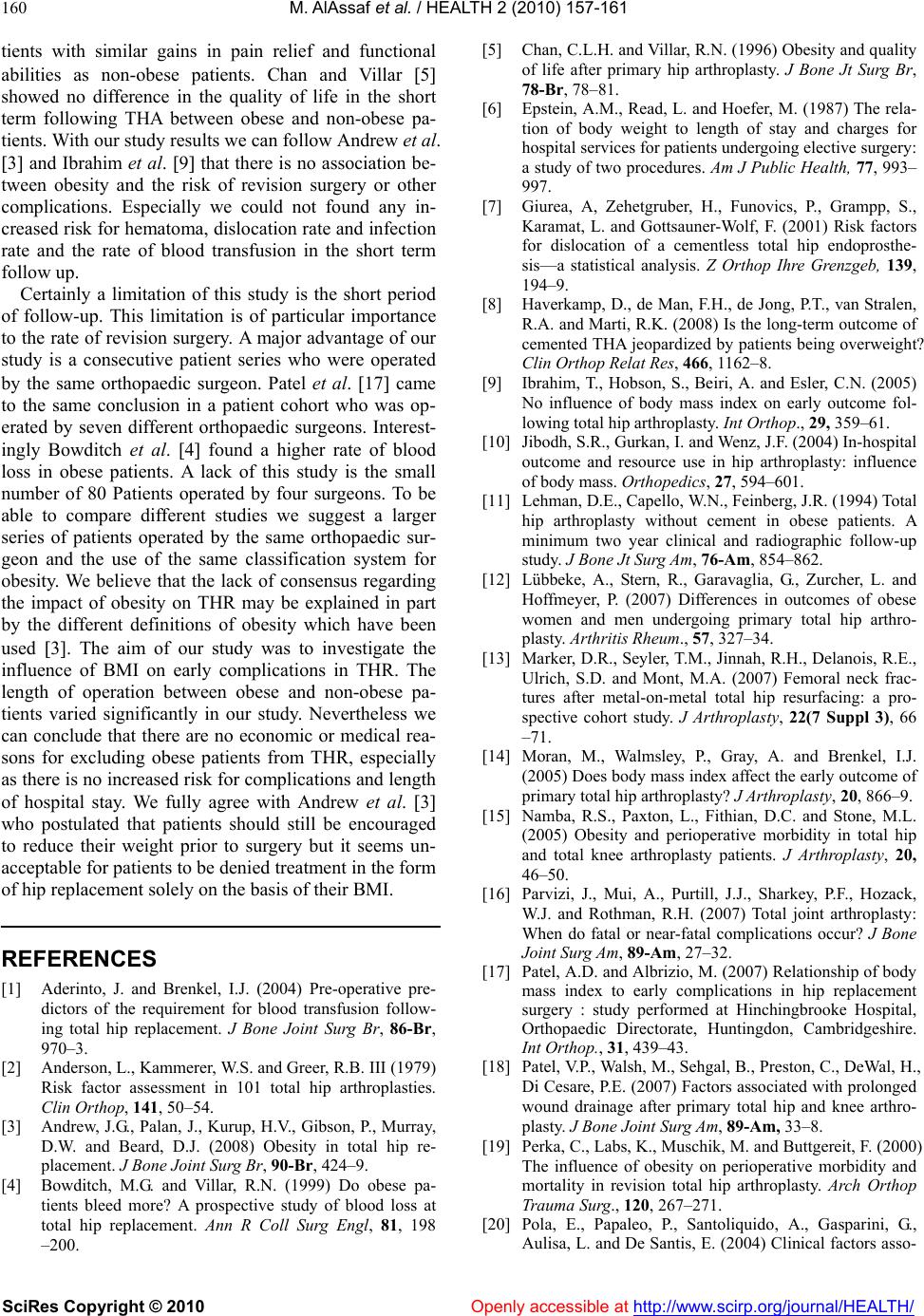
M. AlAssaf et al. / HEALTH 2 (2010) 157-161
SciRes Copyright © 2010 Openly accessible at http://www.scirp.org/journal/HEALTH/
160
tients with similar gains in pain relief and functional
abilities as non-obese patients. Chan and Villar 5
showed no difference in the quality of life in the short
term following THA between obese and non-obese pa-
tients. With our study results we can follow Andrew et al.
3 and Ibrahim et al. 9 that there is no association be-
tween obesity and the risk of revision surgery or other
complications. Especially we could not found any in-
creased risk for hematoma, dislocation rate and infection
rate and the rate of blood transfusion in the short term
follow up.
Certainly a limitation of this study is the short period
of follow-up. This limitation is of particular importance
to the rate of revision surgery. A major advantage of our
study is a consecutive patient series who were operated
by the same orthopaedic surgeon. Patel et al. 17 came
to the same conclusion in a patient cohort who was op-
erated by seven different orthopaedic surgeons. Interest-
ingly Bowditch et al. 4 found a higher rate of blood
loss in obese patients. A lack of this study is the small
number of 80 Patients operated by four surgeons. To be
able to compare different studies we suggest a larger
series of patients operated by the same orthopaedic sur-
geon and the use of the same classification system for
obesity. We believe that the lack of consensus regarding
the impact of obesity on THR may be explained in part
by the different definitions of obesity which have been
used 3. The aim of our study was to investigate the
influence of BMI on early complications in THR. The
length of operation between obese and non-obese pa-
tients varied significantly in our study. Nevertheless we
can conclude that there are no economic or medical rea-
sons for excluding obese patients from THR, especially
as there is no increased risk for complications and length
of hospital stay. We fully agree with Andrew et al. 3
who postulated that patients should still be encouraged
to reduce their weight prior to surgery but it seems un-
acceptable for patients to be denied treatment in the form
of hip replacement solely on the basis of their BMI.
REFERENCES
[1] Aderinto, J. and Brenkel, I.J. (2004) Pre-operative pre-
dictors of the requirement for blood transfusion follow-
ing total hip replacement. J Bone Joint Surg Br, 86-Br,
970–3.
[2] Anderson, L., Kammerer, W.S. and Greer, R.B. III (1979)
Risk factor assessment in 101 total hip arthroplasties.
Clin Orthop, 141, 50–54.
[3] Andrew, J.G., Palan, J., Kurup, H.V., Gibson, P., Murray,
D.W. and Beard, D.J. (2008) Obesity in total hip re-
placement. J Bone Joint Surg Br, 90-Br, 424–9.
[4] Bowditch, M.G. and Villar, R.N. (1999) Do obese pa-
tients bleed more? A prospective study of blood loss at
total hip replacement. Ann R Coll Surg Engl, 81, 198
–200.
[5] Chan, C.L.H. and Villar, R.N. (1996) Obesity and quality
of life after primary hip arthroplasty. J Bone Jt Surg Br,
78-Br, 78–81.
[6] Epstein, A.M., Read, L. and Hoefer, M. (1987) The rela-
tion of body weight to length of stay and charges for
hospital services for patients undergoing elective surgery:
a study of two procedures. Am J Public Health, 77, 993–
997.
[7] Giurea, A, Zehetgruber, H., Funovics, P., Grampp, S.,
Karamat, L. and Gottsauner-Wolf, F. (2001) Risk factors
for dislocation of a cementless total hip endoprosthe-
sis—a statistical analysis. Z Orthop Ihre Grenzgeb, 139,
194–9.
[8] Haverkamp, D., de Man, F.H., de Jong, P.T., van Stralen,
R.A. and Marti, R.K. (2008) Is the long-term outcome of
cemented THA jeopardized by patients being overweight?
Clin Orthop Relat Res, 466, 1162–8.
[9] Ibrahim, T., Hobson, S., Beiri, A. and Esler, C.N. (2005)
No influence of body mass index on early outcome fol-
lowing total hip arthroplasty. Int Orthop., 29, 359–61.
[10] Jibodh, S.R., Gurkan, I. and Wenz, J.F. (2004) In-hospital
outcome and resource use in hip arthroplasty: influence
of body mass. Orthopedics, 27, 594–601.
[11] Lehman, D.E., Capello, W.N., Feinberg, J.R. (1994) Total
hip arthroplasty without cement in obese patients. A
minimum two year clinical and radiographic follow-up
study. J Bone Jt Surg Am, 76-Am, 854–862.
[12] Lübbeke, A., Stern, R., Garavaglia, G., Zurcher, L. and
Hoffmeyer, P. (2007) Differences in outcomes of obese
women and men undergoing primary total hip arthro-
plasty. Arthritis Rheum., 57, 327–34.
[13] Marker, D.R., Seyler, T.M., Jinnah, R.H., Delanois, R.E.,
Ulrich, S.D. and Mont, M.A. (2007) Femoral neck frac-
tures after metal-on-metal total hip resurfacing: a pro-
spective cohort study. J Arthroplasty, 22(7 Suppl 3), 66
–71.
[14] Moran, M., Walmsley, P., Gray, A. and Brenkel, I.J.
(2005) Does body mass index affect the early outcome of
primary total hip arthroplasty? J Arthroplasty, 20, 866–9.
[15] Namba, R.S., Paxton, L., Fithian, D.C. and Stone, M.L.
(2005) Obesity and perioperative morbidity in total hip
and total knee arthroplasty patients. J Arthroplasty, 20,
46–50.
[16] Parvizi, J., Mui, A., Purtill, J.J., Sharkey, P.F., Hozack,
W.J. and Rothman, R.H. (2007) Total joint arthroplasty:
When do fatal or near-fatal complications occur? J Bone
Joint Surg Am, 89-Am, 27–32.
[17] Patel, A.D. and Albrizio, M. (2007) Relationship of body
mass index to early complications in hip replacement
surgery : study performed at Hinchingbrooke Hospital,
Orthopaedic Directorate, Huntingdon, Cambridgeshire.
Int Orthop., 31, 439–43.
[18] Patel, V.P., Walsh, M., Sehgal, B., Preston, C., DeWal, H.,
Di Cesare, P.E. (2007) Factors associated with prolonged
wound drainage after primary total hip and knee arthro-
plasty. J Bone Joint Surg Am, 89-Am, 33–8.
[19] Perka, C., Labs, K., Muschik, M. and Buttgereit, F. (2000)
The influence of obesity on perioperative morbidity and
mortality in revision total hip arthroplasty. Arch Orthop
Trauma Surg., 120, 267–271.
[20] Pola, E., Papaleo, P., Santoliquido, A., Gasparini, G.,
Aulisa, L. and De Santis, E. (2004) Clinical factors asso-